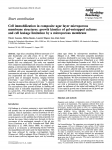Is there any information on why alginate is a preferred gelling agent for cell immobilization instead of something based on agar, gelatin, or an agar/gelatin mixture?
from a bit of my research, it seems that it is because alginate effectively prevents cell leakage, that is - it prevents the cells from escaping the beads and going into solution - which in cases where this is desired to increased alkaloid content, often cells growing freely in the medium will lower the yield.
pre-gelled agar does not apparently dissolve in water without heating, and you would think that with a sufficient density say, 100 grams of agar per liter or so that it may be useful in the same way alginates are to prevent cell leakage.
A mixture of gelatin, agar or each individually might prove to be decently useful.. see attached paper dealing with agar.
That reference, would be useful to read fully, I believe.
There are also other gelling agents, such as agarose, chitin, and carageenin and I bet a few others that may or may not be of interest.
Any ideas or suggestions on substitutes for alginate?
I know it is already easily obtainable, but it would be interesting to experiment with others, and combination, as they may have more to offer...
Temperature might be an issue - obviously if the gelling agent is turned liquid at a temperature which kills the organism, that would defeat the purpose - the alginate beads can form by the addition of a sodium alginate solution, I assume with the organism in it already, to a calcium chloride solution - though I could be wrong - they might add the organism later?
Agar which require heating to melt may be disadvantages because of that alone, and not because of its properties on preventing cell leakage. It may work just as well but be inconvenient because of the heat.
from a bit of my research, it seems that it is because alginate effectively prevents cell leakage, that is - it prevents the cells from escaping the beads and going into solution - which in cases where this is desired to increased alkaloid content, often cells growing freely in the medium will lower the yield.
pre-gelled agar does not apparently dissolve in water without heating, and you would think that with a sufficient density say, 100 grams of agar per liter or so that it may be useful in the same way alginates are to prevent cell leakage.
A mixture of gelatin, agar or each individually might prove to be decently useful.. see attached paper dealing with agar.
That reference, would be useful to read fully, I believe.
Quote
- hxxp://www.springerlink.com/content/v1721l8403461251/
Applied Microbiology and Biotechnology
Volume 38, Number 4, 478-481, DOI: 10.1007/BF00242941
Biotechnology
Cell immobilization in composite agar layer microporous membrane structures: growth kinetics of gel-entrapped cultures and cell leakage limitation by a microporous membrane
Thierry Jouenne, Hélène Bonato, Laurent Mignot and Guy-Alain Junter
There are also other gelling agents, such as agarose, chitin, and carageenin and I bet a few others that may or may not be of interest.
Quote
The term "polymer matrix" shall refer to a polymerized matrix composed of any polymer material known in the art which is liquid in a nonpolymerized state and which is semi-solid in a polymerized state and which does not disrupt the growth of cells entrapped within the polymer matrices, and particles which solidify at about room temperature and which liquify at elevated temperatures without disrupting the growth of the entrapped cells and which form cavities within the polymerized matrix in which the entrapped cells grow. Preferably the matrix is polymerized in the shape of beads. Polymer materials which polymerize to form polymer matrices, include but are not limited to, alginate, carageenin, chitin, and agarose. Especially preferred is the use of alginate as the polymer matrix.-- http://www.freepatentsonline.com/5073491.html
Any ideas or suggestions on substitutes for alginate?
I know it is already easily obtainable, but it would be interesting to experiment with others, and combination, as they may have more to offer...
Temperature might be an issue - obviously if the gelling agent is turned liquid at a temperature which kills the organism, that would defeat the purpose - the alginate beads can form by the addition of a sodium alginate solution, I assume with the organism in it already, to a calcium chloride solution - though I could be wrong - they might add the organism later?
Agar which require heating to melt may be disadvantages because of that alone, and not because of its properties on preventing cell leakage. It may work just as well but be inconvenient because of the heat.




